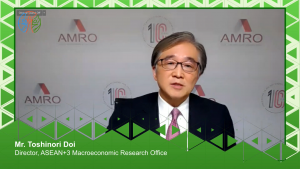
AMRO Director Toshinori Doi speaks virtually at the 1st V20 Climate Vulnerables Finance Summit on July 8, 2021.
Speech by AMRO Director Mr. Toshinori Doi
1st V20 Climate Vulnerables Finance Summit
July 8, 2021
(As prepared for delivery)
ASEAN: Securing Climate Prosperity
1 Excellencies, Ladies and Gentlemen.
2 I would like to thank the Honorable Finance Minister and V20 Chair, Excellency AHM Mustafa Kamal for convening this roundtable at a very apt time.
3 In Southeast Asia, the pandemic pushed the regional economy in 2020 into a deeper contraction than in any previous crises. The ASEAN+3 Macroeconomic Research Office, or AMRO in short, forecasts that the ASEAN region will rebound by 4.5 percent this year and further gain traction next year, to expand by 5.5 percent.
4 The long-term growth outlook for ASEAN will depend on how the region manages risks to macroeconomic and financial stability, especially the perennial and increasingly important threats posed by climate change and natural disasters.
5 With more than 50 million households already living under the poverty line, this region is vulnerable to extreme weather and climate events, especially in countries that are highly dependent on agricultural production, fisheries, and other natural resources.
6 For example, economic loss and damage from natural disasters amounted to more than 10 percent of GDP for several ASEAN countries: Lao PDR from a severe storm in 1993, and Thailand from severe flooding in 2011.
7 The COVID-19 pandemic has provided impetus for the region to consider new drivers of future growth, emphasizing resilience, and social and environmental sustainability. The severity and multi-generational impact of natural disasters underscore the urgency of investing in climate-proof infrastructure, climate-smart agricultural practices, and other mitigating measures.
8 Any manifestation of climate change risks could likewise spill into ASEAN financial systems, magnifying their impact on the real economy. More frequent and intense disasters could lead to rising credit defaults as banks’ collateral values fall, while the still-developing insurance industry would also be exposed.
9 Achieving “climate prosperity” will be highly challenging for the ASEAN region. Varying levels of economic development, resource availability, and vulnerability to climate change mean that each economy faces unique challenges in balancing national climate change targets and socioeconomic objectives.
10 Confronting climate change requires ASEAN policymakers to collaborate on climate risks and responses, and deepen their understanding of common environmental threats and impact.
11 Last year’s adoption of the ASEAN Agreement on Disaster Management and Emergency Response Work Programme 2021–25, with its emphasis on prevention, mitigation, preparedness, and resilient recovery, is a step in the right direction.
12 ASEAN Central Banks are also working together to make the financial system greener and protect it from climate related risks.
13 The ASEAN region cannot evade climate change—but it can prepare itself better against the impact of natural disasters and extreme weather conditions. Concerted regional collaboration, with proactive and consistent implementation of climate risk reduction principles will be the key.
14 AMRO, as the macroeconomic surveillance institution of the ASEAN+3 region, will mainstream climate change in our country surveillance work, and collaborate with our member countries to make the region more resilient to disasters, safer for its many communities, and help it to secure “climate prosperity.”
Thank you.
